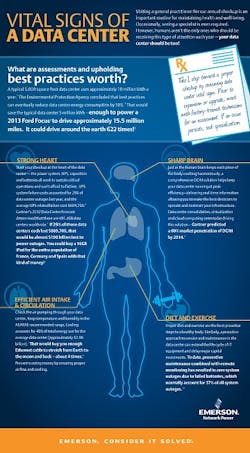Infographic: 5 vital signs of healthy data center infrastructure
Emerson Network Power (NYSE: EMR) has released a list of five vital signs to help critical facilities managers assess the health of their data center infrastructure. The list, and accompanying infographic, details five vital signs of a healthy 5,000 square-foot data center. It's the company's hope that the list "can aid IT managers by helping them to examine the current performance of their data centers and understanding the keys to maintain availability, efficiency, and reliability."
"Just as there is renewed focus on health and physical fitness by many people in the summer months, so too should data center managers assess the health and physical fitness of their critical systems," asserts Dave Saliaris, vice president of life cycle management services for Emerson Network Power’s Liebert Services business.
More news: Emerson embeds remote diagnostics for data center infrastructure
According to Emerson Network Power, data center managers can begin assessing the state of their own data center by examining the current performance of the following vital signs.
1. Effective Cooling: Cooling accounts for approximately 40 percent of total energy used within the average data center. Smart design and implementation of mechanisms can help improve efficiency and lower total cost of operation. According to the Emerson white paper “Seven Best Practices for Increasing Efficiency, Availability and Capacity,” properly designed supplemental cooling has been shown to reduce cooling energy costs by 35-50 percent compared to perimeter cooling. In addition to proper cooling equipment, proper temperature can result in savings. The white paper showed that a 10 degree increase in cold aisle temperature can generate a 20 percent reduction in cooling system energy usage. As a best practice, keep temperature and humidity within the ASHRAE recommended range.
2.Flexibility and Scalability: Healthy data center designs should incorporate well thought out floor layouts, systems and equipment to meet current data center requirements, while ensuring the ability to adapt to future growth and demands. According to Emerson's Fall 2012 Data Center Users’ Group Special Report, 40 percent of respondents expect to run out of data center capacity by 2014, while another 29 percent expect capacity constraints by 2017. Additionally, the survey showed data centers are running out of power and cooling capactiy before they run out of physical floor space.
3.Reliable and Cost-Saving Power and Energy: According to the Emerson white paper “Understanding the Cost of Data Center Downtime,” UPS system failure accounted for 29 percent of data center outages in 2011, and the average UPS-related failure cost $687,700. Ensuring that the UPS, capacitors and batteries are all properly working is the best way to ensure the sustainability of critical operations and avoid data center downtime. Likewise, maintaining energy efficiency can create similar savings. Emerson's Energy Logic industry intelligence has shown that 1 W of savings at the server component level can create 2.84 W of savings at the facility level.
4.Routine Service and Maintenance: For established facilities, preventive maintenance has proven to increase system reliability. For example, Emerson's white paper, “The Effect of Regular, Skilled Preventive Maintenance on Critical Power System Reliability” shows that the UPS Mean Time Between Failures for units that received two preventive service events in a year is 23 times higher than a machine with no preventive services events per year. When correctly implemented, preventive maintenance ensures maximum reliability of data center equipment by providing systematic inspection, detection, and correction of incipient failures that can lead to costly downtime. A Ponemon Institute study of U.S.-based data centers reveals that data center downtime costs businesses more than $5,000 per minute.
5. Proper Planning and Assessment: Preventive maintenance should be supplemented by periodic data center assessments, which can help identify vulnerabilities and inefficiencies resulting from constant change. Not only can assessments indentify potential problem areas in the data center before they become costly issues, but they can also ensure the proper resources and space necessary for maximum efficiency and future growth.
“Today’s data center is one of the most dynamic and imperative operations of any organization, and understanding its vital signs is key to getting the right kind of service at the right time," concludes Emerson's Saliaris. "Complexity and criticality continues to increase as data centers experience steady growth in capacity and density."
Download Emerson's full-sized 'Vital Signs of a Data Center' infographic here.
Related: Heat rises among data center managers’ concerns
